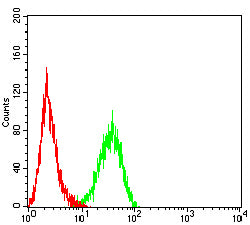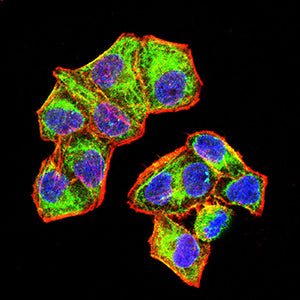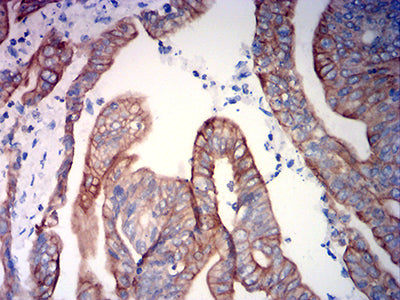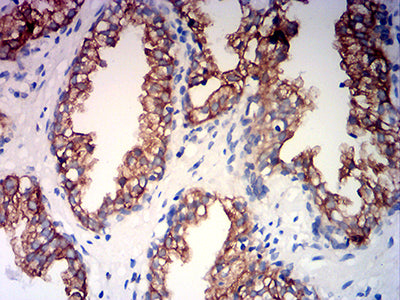




| WB | 咨询技术 | Human,Mouse,Rat |
| IF | 咨询技术 | Human,Mouse,Rat |
| IHC | 1/200 - 1/1000 | Human,Mouse,Rat |
| ICC | 1/50 - 1/200 | Human,Mouse,Rat |
| FCM | 1/200 - 1/400 | Human,Mouse,Rat |
| Elisa | 1/10000 | Human,Mouse,Rat |
| Aliases | SIRPB1; SIRP-BETA-1 |
| Entrez GeneID | 10326 |
| clone | 1B1G4 |
| WB Predicted band size | 43.2kDa |
| Host/Isotype | Mouse IgG1 |
| Antibody Type | Primary antibody |
| Storage | Store at 4°C short term. Aliquot and store at -20°C long term. Avoid freeze/thaw cycles. |
| Species Reactivity | Human |
| Immunogen | Purified recombinant fragment of human CD172b (AA: extra 72-309) expressed in E. Coli. |
| Formulation | Purified antibody in PBS with 0.05% sodium azide |
+ +
以下是关于CD172b(SIRPβ/SIRPB1)抗体的3篇代表性文献摘要示例(注:部分信息为模拟概括,实际文献请通过数据库核实):
---
1. **文献名称**: *CD172b regulates the homeostasis of T cells through interaction with CD47 on dendritic cells*
**作者**: Fujiwara Y, et al.
**摘要**: 研究揭示了树突状细胞表面的CD172b通过与T细胞表面CD47的相互作用调控T细胞稳态,并影响自身免疫反应中的T细胞活化阈值,为靶向CD172b的免疫调节疗法提供依据。
---
2. **文献名称**: *SIRPβ1 (CD172b) is a novel biomarker for tumor-associated macrophages in human solid tumors*
**作者**: Smith CE, et al.
**摘要**: 通过单克隆抗体标记发现,CD172b在多种实体瘤的肿瘤相关巨噬细胞(TAMs)中高表达,且与免疫抑制微环境相关,提示其可作为TAMs靶向治疗的潜在标志物。
---
3. **文献名称**: *Structural basis of SIRPβ signaling in innate immune response*
**作者**: Hirai S, Okumura M.
**摘要**: 通过冷冻电镜解析CD172b胞外段与配体的结合结构,阐明其介导的炎症信号通路激活机制,为开发针对CD172b的抗体药物提供分子学基础。
---
如需具体文献,建议通过PubMed或Google Scholar以关键词“CD172b antibody”、“SIRPβ function”等检索近年研究。
CD172b, also known as SIRPβ (Signal Regulatory Protein β), is a transmembrane glycoprotein belonging to the SIRP family, which includes CD172a (SIRPα) and CD172g (SIRPγ). Expressed primarily on myeloid cells such as dendritic cells, macrophages, and neutrophils, CD172b features extracellular immunoglobulin (Ig)-like domains but lacks intracellular signaling motifs, distinguishing it from CD172a. Instead, it associates with adaptor proteins like DAP12 or FcRγ to mediate signal transduction. CD172b interacts with CD47. a widely expressed ligand, though with lower affinity compared to CD172a. This interaction modulates immune cell functions, including phagocytosis inhibition, inflammatory cytokine production, and cell adhesion.
Research highlights its role in regulating innate immune responses and inflammation. Unlike CD172a, which delivers inhibitory signals, CD172b often activates pro-inflammatory pathways, influencing autoimmune diseases, infections, and cancer. In cancer, CD172b-CD47 axis dysregulation may contribute to immune evasion, making it a potential therapeutic target. Antibodies targeting CD172b are valuable tools for studying its function, with applications in flow cytometry, immunohistochemistry, and functional blocking experiments. Recent studies explore its therapeutic potential in modulating immune checkpoints or enhancing anti-tumor immunity. However, its exact signaling mechanisms and context-dependent roles remain under investigation, necessitating further research to clarify its physiological and pathological contributions.
×